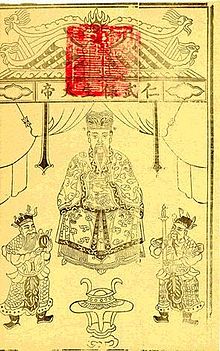
Religion in China is diverse and most Chinese people are either non-religious or practice a combination of Buddhism and Taoism with a Confucian worldview, which is collectively termed as Chinese folk religion.
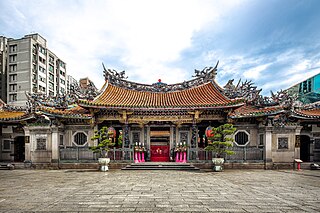
Bangka Lungshan Temple is a Chinese folk religious temple in Wanhua District, Taipei, Taiwan. The temple was built in Taipei in 1738 by settlers from Fujian during Qing rule in honor of Guanyin. It served as a place of worship and a gathering place for the Chinese settlers. In addition to its Buddhist elements, it includes halls and altars to Chinese deities such as Mazu and Guan Yu.

Chinese folk religion, also known as Chinese popular religion, comprehends a range of traditional religious practices of Han Chinese, including the Chinese diaspora. Vivienne Wee described it as "an empty bowl, which can variously be filled with the contents of institutionalised religions such as Buddhism, Taoism, Confucianism and Chinese syncretic religions". This includes the veneration of shen (spirits) and ancestors. Worship is devoted to deities and immortals, who can be deities of places or natural phenomena, of human behaviour, or founders of family lineages. Stories of these gods are collected into the body of Chinese mythology. By the Song dynasty (960–1279), these practices had been blended with Buddhist, Confucian, and Taoist teachings to form the popular religious system which has lasted in many ways until the present day. The present day government of mainland China, like the imperial dynasties, tolerates popular religious organizations if they bolster social stability but suppresses or persecutes those that they fear would undermine it.

Lotus Pond is an artificial lake and popular tourist destination on the east side of Zuoying District in Kaohsiung, Taiwan. Opened in 1951, it is famous for the lotus plants on the lake and the numerous temples around the lake, including the Spring and Autumn Pavilions (春秋閣), the Dragon and Tiger Pagodas (龍虎塔), and the Confucian Temple (孔廟).

Religion in Taiwan is characterised by a diversity of religious beliefs and practices, predominantly those pertaining to the continued preservation of the ancient Chinese culture and religion. Freedom of religion is inscribed in the constitution of the Republic of China (Taiwan). The majority of Taiwanese people practice a combination of Buddhism and Taoism often with a Confucian worldview, which is collectively termed as Chinese folk religion.

Zhinan Temple is a Taoist temple on the slopes of Houshan in Wenshan District of Taipei, Taiwan. It was founded in 1882. The temple's main deity is Lü Dongbin, one of the Eight Immortals. As Lü is said to dwell in the southern courtyard of the heavenly court, the temple acts as a compass pointing toward the south ; hence the name.

Hsing-tian Temple is a popular temple in Zhongshan District, Taipei, Taiwan. This temple is devoted to Lord Guan, the Patron Deity of businessmen, military personnel and policeman. This temple is situated on a street corner near the center of the city. Sculptures of dragons feature prominently in this temple's design. It covers over 7,000 square meters.

Chinese temple architecture refer to a type of structures used as place of worship of Chinese Buddhism, Taoism, Confucianism, or Chinese folk religion, where people revere ethnic Chinese gods and ancestors. They can be classified as:
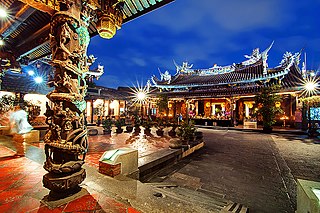
Dalongdong Baoan Temple also known as the Taipei Baoan Temple (臺北保安宮) is a Chinese folk religion temple built in the Datong District, Taipei, Taiwan. The present temple was originally built by clan members in Tong'an, Xiamen, Fujian, who immigrated to Taipei in the early 19th century and gave the temple the name Po-an in order to "protect those of Tong'an" (保佑同安). The Taipei Confucius Temple is located adjacent to the Baoan Temple.
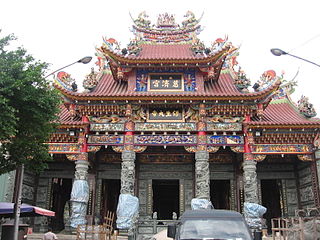
Zuoying Ciji Temple or Bao Sheng Da Di Temple (保生大帝) is a temple by Lotus Lake in Zuoying District, Kaohsiung, Taiwan.

Chinese ritual mastery traditions, also referred to as ritual teachings, or Folk Taoism, or also Red Taoism, constitute a large group of Chinese orders of ritual officers who operate within the Chinese folk religion but outside the institutions of official Taoism. The "masters of rites", the fashi (法師), are also known in east China as hongtou daoshi (紅頭道士), meaning "redhead" or "redhat" daoshi, contrasting with the wutou daoshi (烏頭道士), "blackhead" or "blackhat" priests, of Zhengyi Taoism who were historically ordained by the Celestial Master.

Nuo folk religion, or extendedly, Chinese popular exorcistic religion, is a variant of Chinese folk religion with its own system of temples, rituals, orders of priests, and gods that is interethnic and practiced across central and southern China but is also intimately connected to the Tujia people. It arose as an exorcistic religious movement, which is the original meaning of nuó. It has strong influences from Taoism.

Chinese gods and immortals are beings in various Chinese religions seen in a variety of ways and mythological contexts.

The Wǔfāng Shàngdì, or simply Wǔdì or Wǔshén are, in Chinese canonical texts and common Chinese religion, the fivefold manifestation of the supreme God of Heaven. This theology dates back at least to the Shang dynasty. Described as the "five changeable faces of Heaven", they represent Heaven's cosmic activity which shapes worlds as tán 壇, "altars", imitating its order which is visible in the starry vault, the north celestial pole and its spinning constellations. The Five Deities themselves represent these constellations. In accordance with the Three Powers they have a celestial, a terrestrial and a chthonic form. The Han Chinese identify themselves as the descendants of the Red and Yellow Deities.

Cāngdì of Dōngyuèdàdì is the manifestation of the supreme God associated with the essence of wood and spring, for which he is worshipped as the god of fertility. The Bluegreen Dragon is both his animal form and constellation, and as a human, he was Tàihào 太昊. His female consort is the goddess of fertility Bixia. His astral body is Jupiter.

The roles of women in Taoism have differed from the traditional patriarchy over women in ancient and imperial China. Chinese women had special importance in some Taoist schools that recognized their transcendental abilities to communicate with deities, who frequently granted women with revealed texts and scriptures. Women first came to prominence in the Highest Clarity School, which was founded in the 4th century by a woman, Wei Huacun. The Tang dynasty (618–907) was a highpoint for the importance of Daoist women, when one-third of the Shangqing clergy were women, including many aristocratic Taoist nuns. The number of Taoist women decreased until the 12th century when the Complete Perfection School, which ordained Sun Bu'er as the only woman among its original disciples, put women in positions of power. In the 18th and 19th centuries, women Taoists practiced and discussed nüdan, involving gender-specific practices of breath meditation and visualization. Furthermore, Taoist divinities and cults have long traditions in China, for example, the Queen Mother of the West, the patron of xian immortality, He Xiangu, one of the Eight Immortals, and Mazu, the protectress of sailors and fishermen.
Dacheng Xian'an Temple is a temple located in Dacheng Township, Changhua County, Taiwan. The temple is dedicated to Baosheng Dadi, the God of Medicine, and is protected as a county-level historical building.

Yuanbao Temple is a temple located in North District, Taichung City, Taiwan. The temple is dedicated to the Taoist deity Baosheng Dadi.

Emperor Xiyue is a Taoist deity of the sacred mountain Mount Hua and one of the Great Emperor of Five Mountains. It is said that the worship of Xiyue Dadi can be traced back to the Shang dynasty when he was revered as the ancestor of Dayu. In the period of Emperor Wu of the Han Dynasty, a large-scale sacrificial temple was constructed for Xiyue Dadi as a gesture of respect towards this deity. Xiyue Dadi is the father of Huashan Erlang, Huashan Sanlang and Huayue Sanniang.
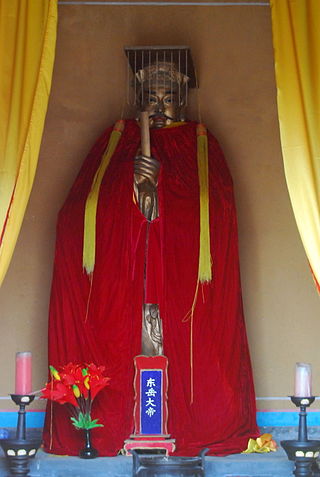
Emperor Dongyue is a Daoist deity of the sacred mountain Mount Tai. He is also believed to be the leader of a large bureaucratic celestial ministry overseeing the maintenance of the Book of Life (生死簿), a register of the due dates on which each and every human soul must be summoned before the Judges of Hell for judgement. Dongyue Dadi is also considered significant in Chinese Buddhism. He is the personification of Cangdi as the "Great Deity of the Eastern Peak" (东岳大帝), which is Mount Tai. As the incarnation of Mount Tai, he is the holy messenger of communication between heaven and the world, and the patron saint of the emperors of all dynasties who was ordered by the sky to govern the world.
